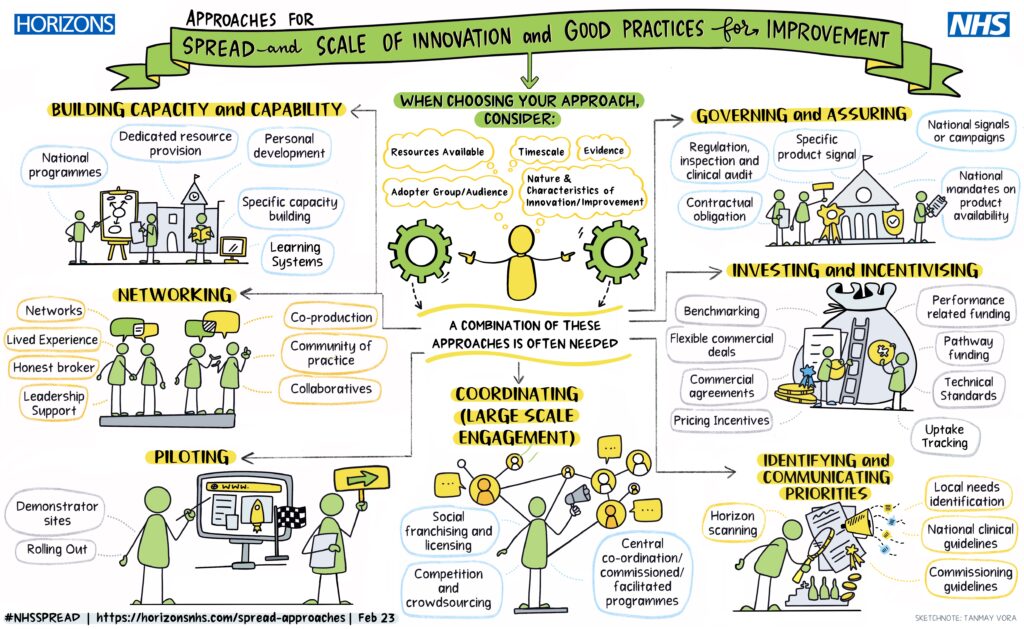Practical tools and methods
Content
Approaches to Spread and Scale
The methods and levers available to system and policy leaders to support spread and scale of innovation and good practices for improvement are collated into seven approaches, details are on the Horizons website.
You will find these tools and methods useful in your work enabling spread and adoption and in systems convening.
Tools and methods
What |
Purpose |
| Liberating structures | Liberating Structures is an alternative way to approach and design how people work together with complexity and helps to create adaptive spaces. There is a menu of thirty-three Liberating Structures to replace or complement conventional practices, also shown here diagrammatically. More detail at Liberating Structures website and Q website. |
| Skills for collaborative change: a map and user guide | Describes the skills and attitudes needed for collaborative problem-solving to support individuals and teams to have meaningful conversations about what it takes to do collaboration well and how to use those skills in practice. Map and guide at Skills for Collaborative change. |
| Shared purpose | ‘Our shared purpose’ is the guiding light for any team, network or community involved in a change process that involves people. How to define our shared purpose. |
| Energy for change | Energy change model provides a framework for helping leaders to build energy for change focused on the five energies: Spiritual, Social, Physical, Psychological and Intellectual [model and blog]. |
| Cynefin framework and Stacey model | Cynefin framework and Stacey model are used to understand complexity, details at Complexity further information. |
| Storytelling | The power of storytelling explains the what, why and how of storytelling. Narrative Making For Systems Changers guide to help craft stories. |
| Public narrative | Public narrative enables communication in an authentic way, resources available here Leading Change Network, including Public narrative resources and Marshall Ganz. |
| Change platforms | Change platforms connect, enable sense checking and share learning across broad groups incl. patients. Examples: The Academy of Fabulous Stuff, Future NHS collaborative platform (NHS staff). |
| Network weaving | Network weaving utilising network approaches for transformation, details here Network weaving and Q website info. |
| Network development | A set of tools to understand how your network is developing and where to focus your collective attention and effort to ensure that you have the best chance of achieving your purpose and aims at Source4networks. |
| Social media | Social media enables connecting, sharing learning and innovation development. Explanation here of Crowdsourcing and tweetchats. |
| Virtual Collaboration (web and mobile technologies) | Virtual Collaboration increases networking and connections including across boundaries and can create adaptive space, details at NHS Horizons. |
| Accelerated Design Event (ADE) | Accelerated Design Event is a proven and evidence based process for considering important issues quickly and effectively and making collaborative decisions, example. |
| Working Out Loud | Working Out Loud supports knowledge flows, networks and connections especially across weak ties leading to relationships. Details at Working Out Loud website. |
| Learning capture and sharing | Guidance and tools to support systematic learning before, during and after change activity including Lessons Learned Log. |
| Personas | To help bring improvement to all by segmentation and creating personas. Personas as a tool. |
| Stakeholder mapping | Stakeholder mapping enables you to identify everyone who needs to be involved and assess how much time and resource to give to maintaining their involvement and commitment. |
| Polarity mapping | Polarity map and presentation recording (from 23 mins). |
| Quality Improvement (QI) measurement | NHS England measurement publications. |
Support
You may find support for your work enabling spread and adoption from the following:
National support
Q community is a connected community working together to improve health and care quality across the UK and Ireland. It gives professionals and patients the opportunity to connect, share and learn through a range of activities including special interest groups, Q visits, funding opportunities and Q labs. Q is funded by The Health Foundation and NHS England.
Accelerated Access Collaborative (AAC) brings together industry, government, regulators, patients and the NHS to remove barriers and accelerate the introduction of ground-breaking new treatments and diagnostics which can transform care. The AAC supports all types of innovations: medicines, diagnostics, devices, digital products, pathway changes and new workforce models. Help it offers summarised here and includes Clinical Entrepreneur training programme and NHS Innovation Accelerator.
Regional support
The Health Innovation Network (formerly known as AHSN Network) is the innovation arm of the NHS and the collective voice of the 15 health innovation networks across England. They were established by NHS England in 2013 to help adoption and spread of innovation at pace and scale to improve health outcomes and generate economic growth. Each organisation works across a distinct geography, serving a different population in each region.
As bodies that connect NHS and academic organisations, local authorities, the third sector and industry, health innovation networks are catalysts that create the right conditions to facilitate change across whole health and social care economies, with a clear focus on improving outcomes for patients. A case study provided by the Health Innovation Network (formerly AHSN Network) illustrates the success in ‘Improving detection and treatment of Atrial Fibrillation across England’. Information on how health innovation networks can support adoption and spread, and details of your local health innovation network here.
Health Innovation South West offer an immersive training experience through the Spread Academy.
Local support
Check what local support may be available. Names of teams may vary but include: Quality Improvement team, knowledge and library service lead, communications team.

